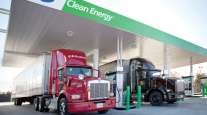Interactive Graphic: State DOT Projects Hitting the Road in 2018

Infrastructure needs have emerged as a top priority for most state administrators who received the go-ahead to spend millions of dollars on repairs as well as new construction projects that range from expanding highways to fixing decrepit roads to installing Intelligent Transportation Systems.
While 2017 brought a bevy of transportation-related projects, government leaders at the state, municipal and federal levels continue to be challenged in 2018 with how to keep freight moving.
SPOTLIGHT ON STATES: Mobility, Modernization Top Goals for Colorado and Michigan Governors
LEADERS' OUTLOOK: Gov. Brian Sandoval's State of the States Address
The American Society of Civil Engineers’ Infrastructure Report Card last year signaled the nation’s most vital transportation arteries — roads and bridges — are in jeopardy. Roadways scored a D, and bridges scored a C-plus. The overall infrastructure grade, including rails and ports, was a D-plus.
President Donald Trump has yet to reveal details of his infrastructure plan, which initially was announced to allot $200 billion from federal accounts and seek $800 billion in private sector investments. He had said that his $1 trillion, 10-year plan would be unveiled in the first 100 days.
But that isn’t discouraging state leaders. Many governors and commissioners of state departments of transportation are ringing in the new year with large projects in a bid to keep pace with rapid growth in their states. Widening roads to accommodate increased commercial and passenger traffic was a common item on many state transportation agendas.
For example, Nevada’s DOT awarded a $65 million contract to expand U.S. Highway 95 in order to accommodate the area’s booming population. Similarly, Arizona DOT is overseeing two widening projects along Interstate 10 outside of Tucson and Phoenix.
The $40 million Phoenix project will help facilitate freight traffic, according to ADOT spokesman Doug Nintzel.
“You have a lot of commercial truck traffic through that area. There is truck traffic from Southern California,” Nintzel said. “That is a busy stretch of I-10.”
Some states are creating new routes instead of expanding. Delaware DOT spokesman Charles McLeod said the agency is in the process of moving the “neck and bottle” of U.S. Route 301 by creating a 14-mile stretch of road that will facilitate freight and passenger traffic. He estimated that 14,000 vehicles a day will use the new roadway. The existing road will remain open to drivers, most of whom will be local travelers, McLeod said.
“It’s really become a difficult section of roadway for our freight truck community to traverse during regular business hours. It slows the trucks down,” McLeod said. “We are really optimistic that this is going to improve the flow of freight traffic through our state. The sole intent is for this really to be used for trucking.”
In addition to building new lanes, bridges, tunnels, interchanges and overpasses, states are repairing and replacing infrastructure.
California’s transportation agency is conducting $1.4 billion in repairs of the Gerald Desmond Bridge, which serves the ports of Los Angeles and Long Beach. The bridge has fallen into such disrepair that a net had to be attached to the underside to catch crumbling debris, California Transportation Secretary Brian Kelly told Transport Topics.
States are embracing new technologies as they renovate aging infrastructure. Many DOTs are testing and installing Intelligent Transportation Systems, devices that allow vehicles to communicate with roadside units, off-site servers and other vehicles.
Take California’s upcoming Otay Mesa East border crossing facility. It will have more room to process trucks and technology that allows for interchangeable lanes.
“It would really be a cutting-edge border crossing that would use intelligent transportation equipment to inform truckers what the wait times are at the various crossings,” Kelly said. “The idea is, instead of getting trucks through in a matter of hours, get them through in a matter of minutes.”
And in Minnesota, the DOT is adding truck parking sensors to seven public rest areas along I-35 and I-94 in the Twin Cities area, according to MnDOT project manager Dan Rowe.
Transport Topics checked in with governors and state department of transportation officials across the country to learn more about their plans for improving the infrastructure. Here’s a glimpse:




